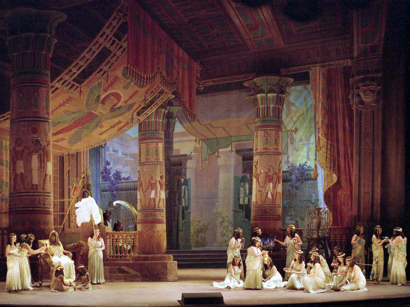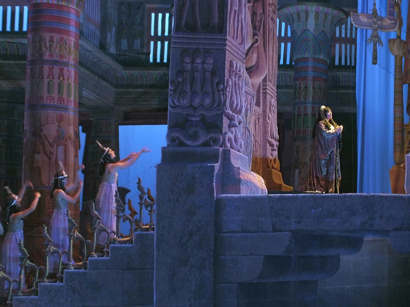Other Links
Editorial Board
- Editor - Bill Kenny
- London Editor-Melanie Eskenazi
- Founder - Len Mullenger
Google Site Search
SEEN
AND HEARD INTERNATIONAL OPERA REVIEW
Verdi, Aida:
Soloists, Orchestra and Chorus Gran Teatre del Liceu de
Barcelona. Conductor. Daniele Callegari, Gran Teatre del Liceu de
Barcelona, 27, 28 and 29. 11. 2007. (JMI)
Barcelona’s Liceu has programmed these performances of Aida with
four different casts. The last one will be presented in January
and will have Norma Fantini and Dolora Zajick as new features. It
is not at all easy to assemble casts for Aida these days,
so it is fair to recognize the enormous effort required to stage
four different ones all with first rate singers.
Italian Micaela Carosi was seen in this same production in Oviedo,
replacing Norma Fantini. I found her then an insipid and
problematic interpreter of the role with a shouted high C. Now she
is much more interesting. The voice does not great beauty, but it
is very well suited to the needs of the role, with a middle range
of sufficient weight and a high register much more secure and
firmer than in Oviedo. She has improved as an interpreter clearly
and she has abandoned certain diva gestures from past
interpretations: now, she is a good choice as a Verdi soprano.
Production: Liceu Barcelona and Festival Santander.
Director: José Antonio Gutiérrez.
Sets: Josep Mestres Cabanes.
Costumes: Franca Squarciapino.
Lighting: Albert Faura.
Casts:
Aida: Hui He, Micaela Carosi, Hasmik Papian.
Radamés: Roberto Alagna, Marco Berti, Piero Giuliacci.
Amneris:Elisabetta Fiorillo, Marianne Cornetti, Larissa Diadkova.
Amonasro:Joan Pons, Ambrogio Maestri, Alberto Mastromarino.
Ramfis: Carlo Colombara, Andrea Papi, Giorgio Giuseppini.
Il
Re: Giorgio Giuseppini, Stefano Palatchi.

These performances take a genuine jump backwards in the history
of the opera and allow us to enjoy the art of Catalan painter
Josep Mestres Cabanes, the set designer, first seen in this same
theater in 1945 and miraculously saved from a big serious fire at
the Liceu. The work of Mestres Cabanes contains truly magical
illusion, obtained by means of clever perspectives, in paintings
of great beauty. The sets include seven different scenes, five
interiors of palaces and temples, one outdoor scene near the Nile
and the Tebas Gate, all of them consisting of painted flats: in
total there are 120 paintings of different sizes, every one
attractive and beautiful. Scene changes are always surprising;
each is like a miracle revealing how a flat surface of paper,
with the aid of a suitable illumination, can create such realistic
impressions of volume and depth. This is a gorgeous display,
really magical for which Liceu should be congratulated since
allows us to see an artistic reconstruction of the first order.
Bright costumes very much in accordance to sets and very good
lighting completes this beautiful production. The stage direction
is not exceptional, but it is necessary to recognize that
spectator interest is necessarily primarily focussed on the sets
in this production.
Daniele Callegari is a regular conductor in this theatre, although
it is not always easy to understand why. His reading was generally
uninteresting, particularly in the firs two acts, with very slow
tempos, most probably due in part to the presence of Mr Alagna,
since in the other performances Mr Callegari was a little faster.
Having just listened to Parma’s orchestra in Bilbao last Saturday,
it is fair to say that Verdi was not well served in Barcelona
this time as the Liceu Orchestra was much better in the hands of
Josep Pons a few weeks ago. There was excellent work from the
chorus however, directed by José Luis Basso.
Fiorenza Cedolins reported ill, and cancelled her Aidas in
Barcelona to be replaced by the Chinese soprano Hui He. I saw Ms
Hui as Aida in Bordeaux two years ago and found her then to be
mostly a lyric soprano. She confirmed this impression here,
offering a pleasant voice rather lacking power in the lower
register, She's a good singer but a limited actress who provided
interesting and valid substitution, but I believe she is more a
Liú than an Aida.

The last Aida was Hasmik Papian. She is a lyric soprano, or
perhaps just a little bit more, and is a reliable singer, capable
of singing piano when the occasion requires it, but she is rather
an impersonal artist. The voice is not bad at all, but there is
rather too much unevenness to it, often within the same register.
She had no problems with her high C, although somehow she broke
the line to prepare for it. A strong element in her favour is that
she cuts a nice figure on stage.
Roberto Alagna was a none too adequate Radams. His 'Celeste Aida'
lacked brightness, and he finished ' Vicino al Sol ' with the
lower variant, as he did at La Scala on the night of the scandal.
This is just a way of avoiding ending with the high B flat in
pianissimo and I do not believe this to be to the audience's. In
the Nile scene he lacked weight enough for the more heroic
outbursts, but improved in the Act IV.
Marco Berti was better adapted to the needs of the role. He is a
good singer whose voice has quality, homogeneity and brightness
and sufficient vocal weight. His biggest problem is that he is
unable to sing softly in upper high register. His Celeste Aida
began very well, but little by little the quality diminished until
finishing with a high B flat that was too short and extremely
loud. He did improve in the Nile Scene, better than the two last
Radamés I've heard, i.e. Alagna and Licitra but was less
noteworthy in the last Act.
Piero Giuliacci was the last Radamés so far and he is one of those
tenors who would have a grander career with a better figure. His
voice has an ample middle range, not very bright and with problems
of projection admittedly, but his upper register has a good
squillo and power. He is a more than a decent singer, able to
sing piano, but his figure and poor skills as an actor,
sadly prevent him from shining. Although a spectator from the
gallery booed with some force after 'Celeste Aida,' I must say
that he was more acceptable than his colleagues in the role,
finishing on a tied high B, which if not a true pianissimo, at
least was no louder than one f. Although not too credible
in the Nile Scene, he produced his best quiet singing therte and
his rendering of “Sacerdote ,Io resto a te” probably was the best
of all the three tenors. His last act fairly average.
Elisabetta Fiorillo was a problematic Amneris. A convincing
interpreter, outstanding at the bottom of the range, her voice
offers little interest in the mid-range and above. Marianne
Cornetti was the best Amneris of the full run, simply because her
voice has a freshness far greater than Fiorillo’s and she is
much easier than Larissa Diadkova with the higher notes: nowadays
Ms .Cornetti has become a Verdian mezzo of much interest. Larissa
Diadkova, seems to have has lost the high notes needed for the
role, which is a pity, because hers continues to be an excellent
voice with a low registers difficult to fault. Unfortunately, it
seems that only Mrs Quickly and Ulrica are valid Verdi characters
for her just now.
Of the Amonasros, Joan Pons was very reliable, sounding as if he
had a cold and showing some evident vibrato in the upper range.
Ambrogio Maestri was also good: his voice has definite quality
and he is a fine singer. Alberto Mastromarino has a poweful
baritone, but his upper register is slightly dull sounding. Even
so, it is difficult to find three better heavy weights than
these.
In order of excellence, Carlo Colombara was a suitable Ramfis,
showing his habitual problem on the high notes, Giorgio Giuseppini
was adequate and Andrea Papi was rather poor. Little remains of
this younger promise. Giorgio Giuseppini and Stefano Palatchi
shared the King, while Josep Fadó was a good Messagiero and Begoña
Alberdi a perfectly correct Sacerdotessa.
The theater was packed every single night, which means that Verdi
continues to be a top seller. There were no particular successes
for anybody and isolated boos were dedicated to Roberto Alagna.
Every night there were some empty seats after the third
intermission, which is too many, although in this case, as this
was a revived historical production, the situation is
understandable.
José M. Irurzun
Pictures © Antonio Bofill
